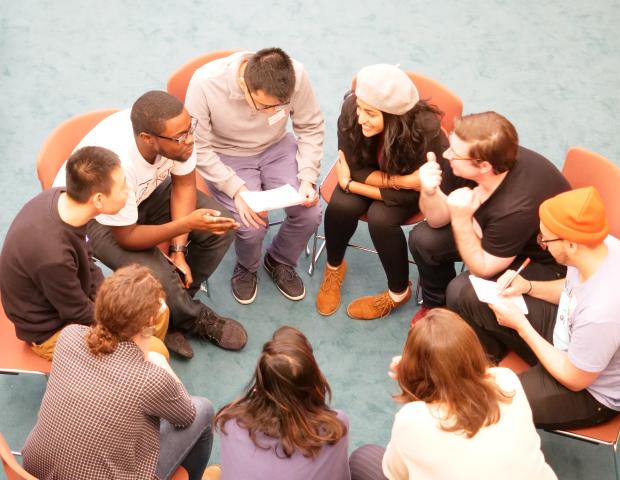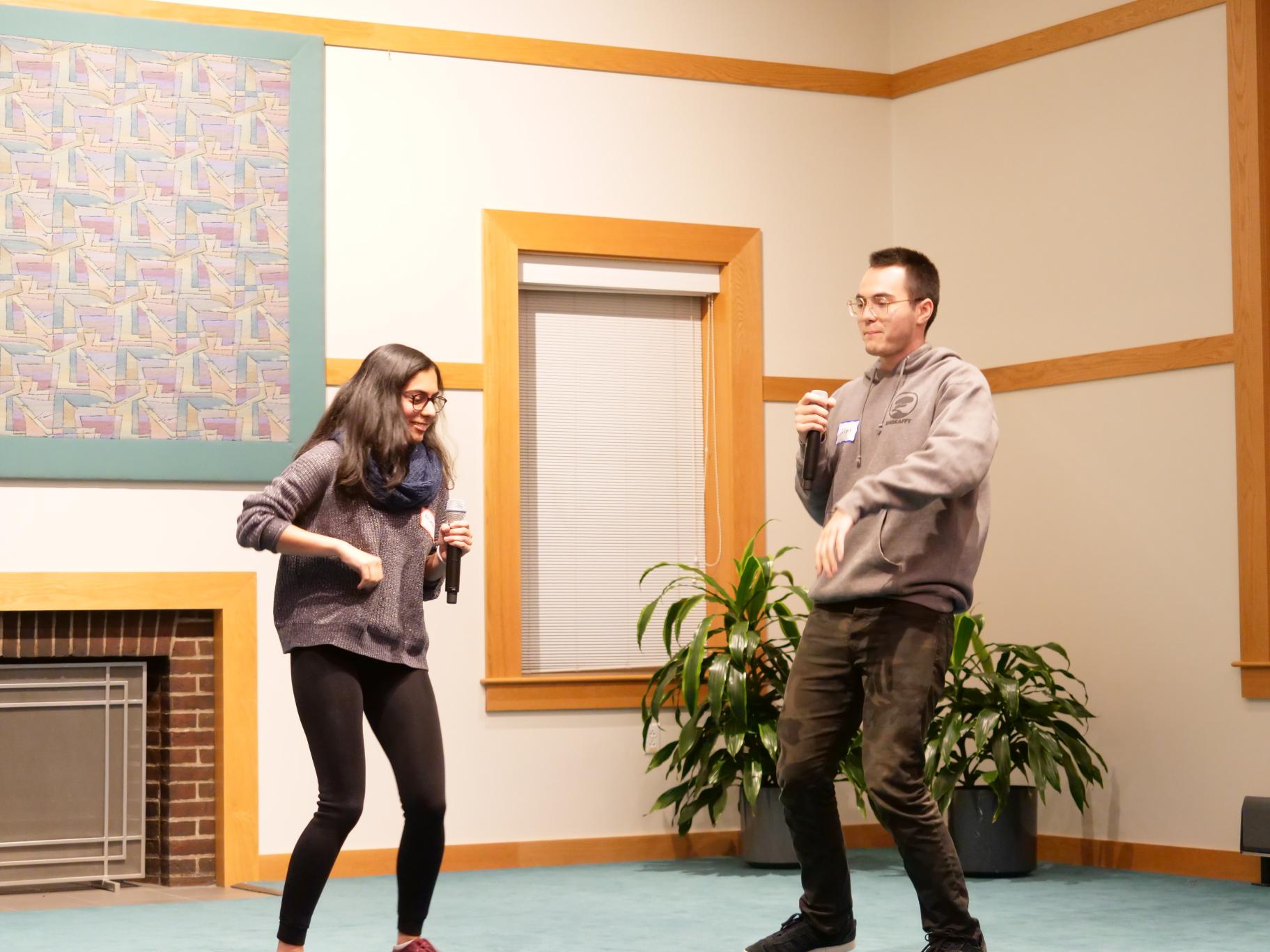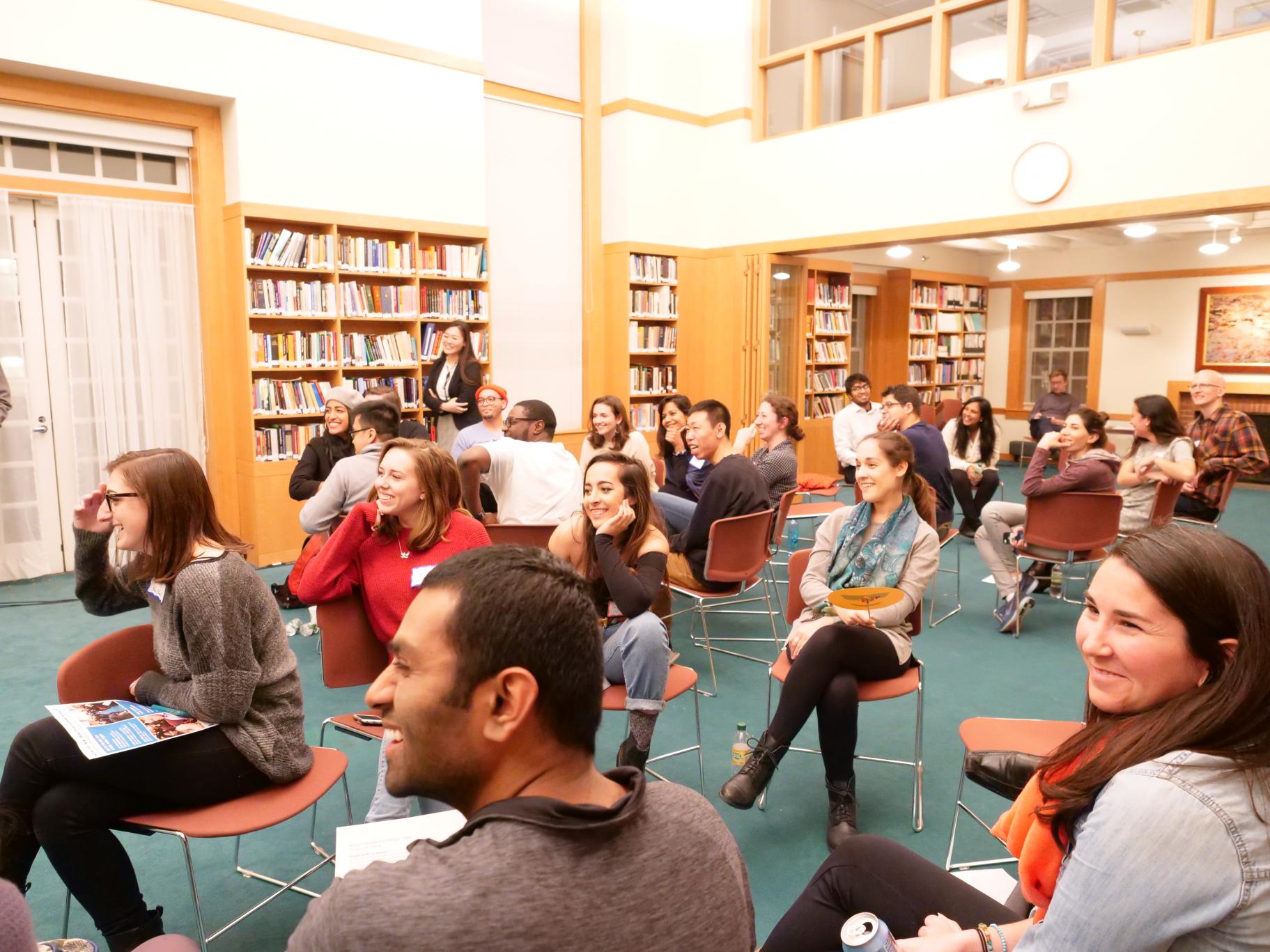Dialogue Nights #8: Creating Hope Through Dialogue
What better way to honor the Ikeda Center’s twenty-fifth anniversary as an institute devoted to peace, learning, and dialogue than to host an event engaging young people in a participatory investigation of the characteristics of genuine, transformative dialogue?
Called “Creating Hope Together: What Is the Role of Dialogue?”, the October 19th Dialogue Nights for students and young professionals was inspired by themes from the writings of Daisaku Ikeda, including his 1993 lecture* at the Harvard-Yenching Institute, considered the Center’s founding lecture.
In her welcoming remarks, Center Program Manager Lillian I drew attention to a few of Ikeda’s ideas in particular. First, it is precisely the severity of our current challenges, social, political, and otherwise, that makes it crucial that we remain committed to dialogue. Said Ikeda: “We persist in dialogue because dialogue has the power to break down the walls of mistrust, hatred, and division in the hearts of people everywhere.” Mr. Ikeda’s assertion is based on his experience witnessing the rejection of dialogue in the militaristic society of pre-World War II Japan as well as on his many decades of experience as a practitioner of open-hearted, open-minded dialogue. Through these experiences, he has gained “a strong confidence in the rich reserves of goodness that are equally the possession of all people, regardless of the civilization into which they are born.” Lillian also observed that since Mr. Ikeda’s philosophy is Buddhist-based, it is “rooted in the rejection of violence.”
Dialogue Takes Practice
Setting up the initial icebreaking activities for the thirty attendees, Lillian asked everyone to raise their hand if they have someone in their life they avoid because they “just don’t want to talk to them.” Nearly every hand went up. Quite understandable, said Lillian, since the truth is that “dialogue is not easy.” Therefore, she said, the evening would provide an opportunity for everyone to “practice it together.”
Icebreaking activities often include some quick, humorous ways for people to interact before tackling more substantive issues. Tonight the icebreaking activities actually functioned as mini dialogues, short in duration but deep in possibility for people to make real connections. With the chairs in the room arranged for paired discussion, participants responded to a series of prompts, each time moving around to engage in dialogue with someone they didn’t know prior to the event. The process is not unlike speed dating, observed Lillian, but aimed at strengthening peacebuilding dialogue skills!
The questions were designed to elicit a sense of shared human experience among attendees, especially in the realm of values. Some examples: Where do you consider home, and why? What are you proud of? What would you like to talk about but find difficult? Where do you think hope comes from and how do you create hope when there is none? What is the most memorable good conversation you’ve had? These quick conversations created a strong energy in the room and demonstrated that dialogue requires a bit of the vulnerability that openness implies to succeed.
What Makes Dialogue Succeed?
For the main activity of the evening, attendees gathered into three groups to create brief skits that members of the group would perform to illustrate ineffective, alienating conversations versus value-creating communications that connect people. To demonstrate, Ikeda Center staffers Preandra Noel and Anri Tanabe gamely acted a skit of their own that riffed on the perennial theme of one roommate accusing the other of not carrying their weight in terms of housecleaning. For the attendees’ skits, they were asked to choose from themes that they had suggested earlier that evening during check-in. These topics ranged from interpersonal matters such as dating dynamics to social matters of injustice and inequality. In her instructions to participants, Lillian advised that they focus less on the content of the skit than on showing the difference in dynamics between respectful and open interactions and encounters marked by self-interest.
The first skit featured two participants acting out positive first-date conversations and two acting out negative ones. The former featured interactions that showed sincere, not smarmy, interest in how the other would like the evening to go; while the latter featured each person being very judgmental and touchy about the other’s behavior and attitude, and inattentive to the other’s preferences. The second skit featured a pair of actors playing out “before and after” scenarios of the interactions between a professor and a student who wants to bring his service pet into class. In the first interaction, which takes place before class, the professor jumped to negative assumptions on how the service pet would disrupt class, while the student argued that he was being treated unjustly. After class, the pair approached each other and admitted they had been assuming worst-case scenarios and that, now that they could see the other’s point of view, they would be able to find a workable routine for the semester. Finally, two men performed a situation where, while they are waiting at a bus stop, one throws a plastic soda container at a trash can, misses, and is content to leave it there. In the negative scenario, the observing man berates the litterer for his irresponsibility, to little effect. In the second, he goes ahead and picks up and disposes of the container himself, while engaging the other in a general, non-personalized discussion of the global problem of plastic waste, to which the litterer is receptive.
After the skits, Lillian asked the groups to discuss the attributes and applications of successful dialogue based on their reactions to the skits as well as on their understanding of Daisaku Ikeda’s vision of genuine dialogue. Observations from the groups were wide ranging but with several cross-cutting themes:
- Dialogue is difficult. You have to be brave enough to be “weak.” And you need to really listen, not just be thinking of your next talking point.
- Everyone has their own authentic path to their beliefs.
- Find common ground; find a way to relate to the other person.
- One group offered a definition: “What we learned about genuine dialogue is that it takes patience, empathy, and open-mindedness, which help create a foundation of understanding
- The negative interactions in the skits were characterized by dismissiveness and little consideration for the other’s feelings, while the positive ones displayed openness to how the other person is perceiving the situation. These attitudes are often displayed in body language.
- Genuine dialogues are open-hearted, seeking a heart connection, while negative encounters are defined by defensiveness.
- The second skit showed you can go back to someone after a negative encounter and re-engage in a more positive way.
- Given the reality of cause and effect, any dialogue can change for the better, and each of us can significantly impact that direction through our intentions.
- Dialogue succeeds by showing interest in someone, asking questions, and making the other person feel comfortable around you.
- Dialogue is not monologue. Dialogue means to engage in conversation with the intention to either accept change or to impart perspective.
- There are times when views are so opposing that it might not be advisable to attempt dialogue. However, when you do try to engage in such difficult dialogues, focusing on building awareness versus changing opinions can be effective.
- In daily life, every encounter can become dialogical when entered into with an open mind.
Seeing Others in Ourselves, and Ourselves in Others
To close the formal portion of the evening (a reception would follow), executive director Virginia Benson thanked the attendees for their “fabulous” insights and energy and shared some further thoughts on the Center’s 25th anniversary and Mr. Ikeda’s philosophy of dialogue. Quite simply, said Benson, from the start the Ikeda Center has striven to engage people from all kinds of backgrounds in open-hearted, open-minded dialogue, and in so doing communicate a “vision of a culture of peace to the world.” In Ikeda’s view, for such dialogue to succeed, three characteristics must be evident,** said Benson, adding that they were very much in evidence over the course of the evening.
First, mutuality must be present. This is defined by a “humble willingness to learn from each other.” Second, each of us must, in Ikeda’s words, “overcome the divisions in our own hearts,” becoming aware of how each of us “unconsciously categorizes people,” unwisely sorting them as good and bad, us and them. This unconscious categorizing, says Mr. Ikeda, “is a deep driver of conflict in this world.” Finally, we know we are engaging in genuine dialogue when we “see others in ourselves, and ourselves in others.”
Above all, said Benson, Mr. Ikeda’s “belief in the value of one-to-one dialogue is ultimately nothing other than a faith in people and in life itself.” So “thank you for working with us tonight to deepen our faith in people and in life itself.” The entire evening, she concluded, “gives me hope that each of us can multiply what we’ve learned here tonight by expanding a culture of genuine dialogue in our lives wherever we go, sending the light of dialogue radiating outward through all of our relationships.”
Notes
* See “Mahayana Buddhism and Twenty-first Century Civilization” in A New Humanism: The University Addresses of Daisaku Ikeda (London and New York: I.B. Tauris, 2010).
** See Daisaku Ikeda’s foreword to the forthcoming volume, Peacebuilding Through Dialogue, developed by the Ikeda Center, and published by George Mason University Press, December 2018.


